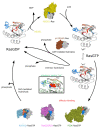Natural Products Attenuating Biosynthesis, Processing, and Activity of Ras Oncoproteins: State of the Art and Future Perspectives
- PMID: 33182807
- PMCID: PMC7698260
- DOI: 10.3390/biom10111535
Natural Products Attenuating Biosynthesis, Processing, and Activity of Ras Oncoproteins: State of the Art and Future Perspectives
Abstract
RAS genes encode signaling proteins, which, in mammalian cells, act as molecular switches regulating critical cellular processes as proliferation, growth, differentiation, survival, motility, and metabolism in response to specific stimuli. Deregulation of Ras functions has a high impact on human health: gain-of-function point mutations in RAS genes are found in some developmental disorders and thirty percent of all human cancers, including the deadliest. For this reason, the pathogenic Ras variants represent important clinical targets against which to develop novel, effective, and possibly selective pharmacological inhibitors. Natural products represent a virtually unlimited resource of structurally different compounds from which one could draw on for this purpose, given the improvements in isolation and screening of active molecules from complex sources. After a summary of Ras proteins molecular and regulatory features and Ras-dependent pathways relevant for drug development, we point out the most promising inhibitory approaches, the known druggable sites of wild-type and oncogenic Ras mutants, and describe the known natural compounds capable of attenuating Ras signaling. Finally, we highlight critical issues and perspectives for the future selection of potential Ras inhibitors from natural sources.
Keywords: Ras druggable pockets; Ras inhibitors; Ras inhibitory strategies; Ras oncogenes; Ras signaling; anticarcinogenic effect; cancer; natural products.
Conflict of interest statement
The authors declare no conflict of interest.
Figures





Similar articles
-
RAS-inhibiting biologics identify and probe druggable pockets including an SII-α3 allosteric site.Nat Commun. 2021 Jun 30;12(1):4045. doi: 10.1038/s41467-021-24316-0. Nat Commun. 2021. PMID: 34193876 Free PMC article.
-
Natural products targeting RAS by multiple mechanisms and its therapeutic potential in cancer: An update since 2020.Pharmacol Res. 2025 Feb;212:107577. doi: 10.1016/j.phrs.2025.107577. Epub 2025 Jan 3. Pharmacol Res. 2025. PMID: 39756556 Review.
-
Pharmacological modulation of oncogenic Ras by natural products and their derivatives: Renewed hope in the discovery of novel anti-Ras drugs.Pharmacol Ther. 2016 Jun;162:35-57. doi: 10.1016/j.pharmthera.2016.03.010. Epub 2016 Mar 22. Pharmacol Ther. 2016. PMID: 27016467 Review.
-
Approaches to Ras signaling modulation and treatment of Ras-dependent disorders: a patent review (2007--present).Expert Opin Ther Pat. 2012 Nov;22(11):1263-87. doi: 10.1517/13543776.2012.728586. Epub 2012 Sep 26. Expert Opin Ther Pat. 2012. PMID: 23009088 Review.
-
Targeting the RAS-dependent chemoresistance: The Warburg connection.Semin Cancer Biol. 2019 Feb;54:80-90. doi: 10.1016/j.semcancer.2018.01.016. Epub 2018 Feb 9. Semin Cancer Biol. 2019. PMID: 29432815 Review.
Cited by
-
Enzymatic Inhibitors from Natural Sources: A Huge Collection of New Potential Drugs.Biomolecules. 2021 Jan 20;11(2):133. doi: 10.3390/biom11020133. Biomolecules. 2021. PMID: 33498517 Free PMC article.
-
Identification of New KRAS G12D Inhibitors through Computer-Aided Drug Discovery Methods.Int J Mol Sci. 2022 Jan 24;23(3):1309. doi: 10.3390/ijms23031309. Int J Mol Sci. 2022. PMID: 35163234 Free PMC article.
-
Quercetin, a Flavonoid with Great Pharmacological Capacity.Molecules. 2024 Feb 25;29(5):1000. doi: 10.3390/molecules29051000. Molecules. 2024. PMID: 38474512 Free PMC article. Review.
-
Targeting Autophagy with Natural Products as a Potential Therapeutic Approach for Cancer.Int J Mol Sci. 2021 Sep 10;22(18):9807. doi: 10.3390/ijms22189807. Int J Mol Sci. 2021. PMID: 34575981 Free PMC article. Review.
-
An in silico molecular docking and simulation study to identify potential anticancer phytochemicals targeting the RAS signaling pathway.PLoS One. 2024 Sep 19;19(9):e0310637. doi: 10.1371/journal.pone.0310637. eCollection 2024. PLoS One. 2024. PMID: 39298437 Free PMC article.
References
Publication types
MeSH terms
Substances
LinkOut - more resources
Full Text Sources
Medical

